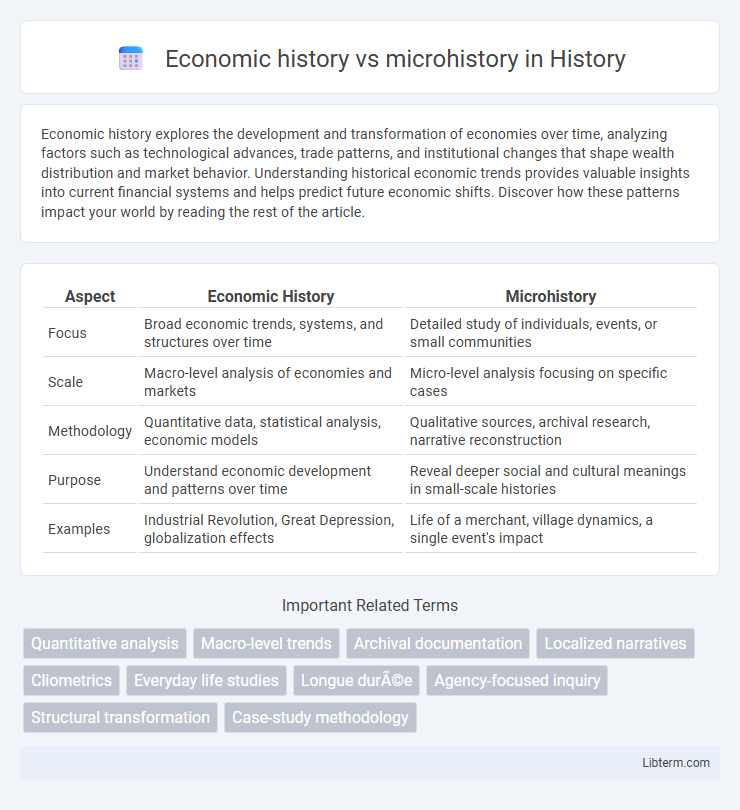Economic history explores the development and transformation of economies over time, analyzing factors such as technological advances, trade patterns, and institutional changes that shape wealth distribution and market behavior. Understanding historical economic trends provides valuable insights into current financial systems and helps predict future economic shifts. Discover how these patterns impact your world by reading the rest of the article.
Table of Comparison
| Aspect | Economic History | Microhistory |
|---|---|---|
| Focus | Broad economic trends, systems, and structures over time | Detailed study of individuals, events, or small communities |
| Scale | Macro-level analysis of economies and markets | Micro-level analysis focusing on specific cases |
| Methodology | Quantitative data, statistical analysis, economic models | Qualitative sources, archival research, narrative reconstruction |
| Purpose | Understand economic development and patterns over time | Reveal deeper social and cultural meanings in small-scale histories |
| Examples | Industrial Revolution, Great Depression, globalization effects | Life of a merchant, village dynamics, a single event's impact |
Defining Economic History and Microhistory
Economic history examines historical changes in economies, focusing on large-scale trends such as industrialization, trade patterns, and economic policies over centuries. Microhistory centers on detailed investigations of specific individuals, communities, or events to reveal broader social and economic dynamics at a granular level. Defining economic history emphasizes macroeconomic structures and long-term processes, while microhistory prioritizes localized, in-depth analysis to uncover overlooked aspects of economic life.
Origins and Evolution of Economic History
Economic history originated in the 19th century as a discipline analyzing broad economic processes, using quantitative data to study industrialization, trade, and growth over time. Microhistory emerged in the 1970s as a response, focusing on intensive case studies of individuals or small communities to reveal detailed socio-economic interactions often overlooked by macroeconomic narratives. The evolution of economic history reflects a shift from grand economic trends to nuanced local experiences, integrating interdisciplinary methods and enriching understanding of economic phenomena across scales.
The Emergence of Microhistory
The emergence of microhistory in the late 20th century shifted historical analysis from large-scale economic patterns to detailed studies of individual lives and local events, enriching our understanding of economic history through granular perspectives. Unlike traditional economic history that emphasizes broad trends and quantitative data, microhistory employs qualitative methods to illuminate the complexities of economic behaviors and social relations in specific contexts. This approach reveals the intricate interactions between economic structures and personal experiences, offering nuanced insights into past economies.
Methodological Approaches: Macro vs. Micro
Economic history employs macro-level methodological approaches, analyzing large-scale economic trends, aggregate data, and institutional frameworks to understand broad economic developments over time. Microhistory focuses on detailed, context-rich examinations of individual events, actors, or communities, using qualitative methods to uncover local experiences and specific social dynamics. The contrast lies in economic history's reliance on quantitative data and long-term patterns versus microhistory's emphasis on narrative depth and granular analysis.
Scales of Analysis: Broad Trends vs. Local Narratives
Economic history examines broad trends such as GDP growth, trade patterns, and industrialization processes across regions or nations, emphasizing macro-level data and long-term developments. Microhistory focuses on local narratives, exploring individual experiences, community dynamics, and small-scale events to reveal nuanced insights often overlooked by larger economic frameworks. The contrast in scales of analysis enables economic history to identify systemic patterns, while microhistory uncovers the granular, contextual factors that shape economic phenomena at the ground level.
Sources and Evidence: Quantitative Data vs. Qualitative Details
Economic history relies heavily on quantitative data such as census records, trade statistics, and financial ledgers to analyze broad economic trends and patterns over time. Microhistory, conversely, emphasizes qualitative details drawn from personal letters, diaries, court records, and local archives to uncover individual experiences and social dynamics within specific communities. These differing sources and evidence types reflect the macro-level focus of economic history compared to the granular, narrative-driven approach of microhistory.
Case Studies: Illustrative Examples from Both Fields
Economic history employs broad quantitative data and macro-level analysis to understand long-term trends in economies, with case studies like the Industrial Revolution in Britain illuminating systemic shifts. Microhistory focuses intensively on detailed, localized episodes such as Carlo Ginzburg's investigation of a 16th-century miller, revealing nuanced social and cultural contexts rarely captured in large-scale studies. Both fields use case studies to uncover complex patterns: economic history emphasizes aggregated economic phenomena, while microhistory highlights individual experiences and their implications for historical understanding.
Strengths and Limitations of Economic History
Economic history excels at analyzing long-term economic trends and large-scale patterns using quantitative data and archival sources, providing insights into the development of economies across different periods and regions. Its strengths lie in systematic analysis and the ability to contextualize economic phenomena within broader social and political frameworks, but it often struggles with incorporating the nuanced, individual experiences that microhistory captures. Limitations include potential overreliance on aggregate data which may obscure local variations and the lived realities of ordinary people.
Strengths and Limitations of Microhistory
Microhistory excels in uncovering detailed, context-rich narratives of specific individuals or events, providing deep insights into social behaviors and local dynamics often overlooked by broader economic history approaches. Its strength lies in revealing complexity and nuance through intensive archival research, yet this focus limits its ability to generalize findings across larger populations or economic systems. Microhistory's limitation includes potential overemphasis on anecdotal evidence, which may not capture wider structural economic trends comprehensively addressed by economic history.
Integrating Macro and Micro Perspectives in Historical Research
Economic history examines large-scale economic trends and institutions over long periods, while microhistory focuses on detailed studies of individuals or small communities. Integrating macro and micro perspectives allows historians to contextualize personal experiences within broader economic forces, revealing how structural changes impact everyday life. This approach enhances understanding of historical processes by combining quantitative data with rich, qualitative narratives.
Economic history Infographic

 libterm.com
libterm.com